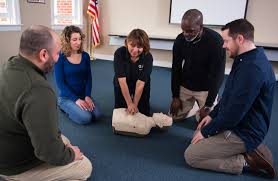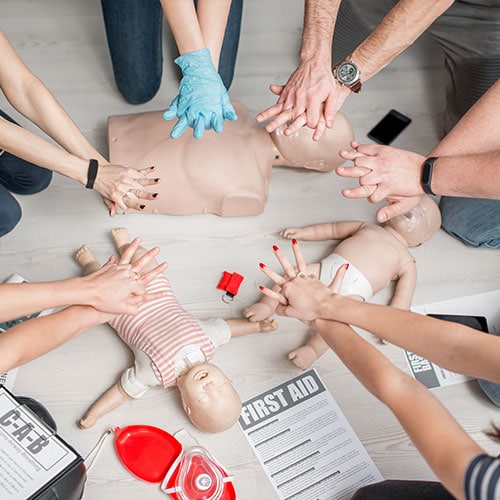Introduction
In today's world, emergencies can strike anytime, and being prepared is crucial. Among the key abilities that can conserve lives is cardiopulmonary resuscitation (MOUTH-TO-MOUTH RESUSCITATION). Teens stand for a crucial population that can be trained to react successfully in emergency situations. By equipping them with mouth-to-mouth resuscitation training, we not just equip them with life-saving abilities yet also cultivate a culture of readiness and obligation. First Aid Course Sydney CBD This short article explores the significance of CPR training for teens, what to anticipate in first aid programs, and exactly how these skills contribute to their personal advancement and area safety.
Understanding mouth-to-mouth resuscitation Educating for Teens: Preparing the Future Generation for Emergencies
What is CPR?
Cardiopulmonary resuscitation (CPR) is a lifesaving method made use of throughout emergency situations when someone's heartbeat or breathing has actually quit. It contains breast compressions and rescue breaths that help preserve blood circulation to vital body organs till specialist medical help arrives. Recognizing the fundamentals of mouth-to-mouth resuscitation is crucial for teenagers that might find themselves in emergency situations.
Why Do Teens Need CPR Training?
Teens are typically at social gatherings, sporting activities events, and even home events where emergencies might occur. By finding out mouth-to-mouth resuscitation, they end up being aggressive members of their neighborhood who can act decisively during dilemmas. The capability to do mouth-to-mouth resuscitation confidently can turn a potentially heartbreaking scenario right into one where lives are saved.
Benefits of Emergency treatment Courses for Teens
First aid courses do greater than just educate participants exactly how to supply immediate treatment; they instill confidence and strengthen analytical skills. For teens, this experience can develop personality and encourage management qualities.
- Empowerment: Knowledge of emergency treatment and CPR encourages young people. Confidence Structure: Successfully completing a program gives teens with a feeling of achievement. Community Service: Educated teens can volunteer in different settings such as institutions or sporting activities teams.
The Structure of mouth-to-mouth resuscitation Courses for Teens
Course Duration and Format
Most first aid training courses are developed to fit within a few hours to a number of days, depending on the deepness of training used. Usually, a fundamental first aid course will cover:

- Theory: The concepts behind first aid techniques. Practical Skills: Hands-on practice with mannequins or via simulations.
Key Components Covered in First Aid Courses
Understanding Emergency Situations- Recognizing when to ask for help Assessing the scene for safety
- Performing premium upper body compressions Providing rescue breaths correctly
- Learning just how to run an AED Importance of early defibrillation
- Techniques for adults, kids, and infants Recognizing signs of respiratory tract obstruction
- Cuts and scrapes Sprains and fractures
The Significance of Certification in Emergency Treatment Training
Obtaining Your Emergency treatment Certificate
Completing an emergency treatment course normally finishes in getting an accreditation that validates your abilities. This certificate serves numerous purposes:
- It demonstrates competence in emergency response. Many organizations need qualification for involvement in certain events.
Keeping Certifications Current
Just like any type of life skill, it is very important to maintain your knowledge up-to-date. The majority of companies suggest restoring qualifications every 2 years.
How Teens Can Obtain Included with Emergency Treatment Training
Finding Neighborhood First Aid Courses
Teenagers interested in gaining their first aid certificate ought to check into local recreation center, institutions, or health organizations that use accredited courses.
Helpful Resources:
- American Red Cross St John Ambulance Local health centers or wellness departments
Online vs In-Person Training Options
With innovations in technology, online components have actually come to be popular yet might lack hands-on practice important for really grasping techniques. A combined approach-- integrating online theory with functional sessions-- might be most beneficial.
Creating Recognition Among Peers concerning Mouth-to-mouth Resuscitation Educating for Teens: Preparing the Next Generation for Emergencies
Peer Education and learning Initiatives
Encouraging teenagers to share what they've learned with their pals can amplify the impact of training programs:

- Forming study groups focused on emergency situation preparedness. Hosting workshops at schools or neighborhood centers.
Using Social Media as a Platform
Teens today are greatly engaged on social networks platforms; making use of these channels can help spread awareness concerning the significance of first aid training among peers.

Real-Life Stories That Emphasize the Significance of CPR Training for Teens
Case Research study 1: Conserving a Life at School Sports Event
A teen trained in CPR was able to save their close friend's life throughout a football match when he collapsed on the area as a result of heart attack. Their quick reasoning allowed them to provide proper breast compressions till emergency solutions arrived.
Case Research study 2: Family Emergency at Home
Another example involved brother or sisters that had actually taken a first aid course together. When their more youthful bro unintentionally choked on food during dinner, they immediately recognized what steps to take since they remembered their training-- leading them effectively through the emergency.
Frequently Asked Inquiries (Frequently Asked Questions) About Teen Mouth-to-mouth Resuscitation Training
1. What age must teenagers start taking CPR courses?
Many organizations recommend beginning as early as 12 years of ages; nonetheless, younger kids can additionally find out standard ideas through ideal programs tailored to their age group.
2. How much time does it require to finish an emergency treatment course?
Programs normally range from 4 hours up to 16 hours relying on web content deepness-- the standard being around 8 hours.
3. Exist any requirements before enrolling?
No official prerequisites exist; nevertheless, it's handy if participants have an understanding of basic medical terms.
4. Will certainly I obtain accreditation after completing my course?
Yes! Upon successful conclusion and passing any needed analyses you'll receive an official emergency treatment certificate valid for 2 years.
5. Can I take these training courses online?
Several institutions offer hybrid formats integrating on-line concept with needed sensible sessions held in person-- this is recommended by sector standards.
6. Is it necessary to renew my certification periodically?
Yes! Normal recertification ensures your skills continue to be skilled and current according to existing guidelines.
Conclusion
In verdict, furnishing young adults with understanding concerning cardiopulmonary resuscitation (MOUTH-TO-MOUTH RESUSCITATION) with specialized training programs is important not just for their development yet likewise enhances community safety on the whole. With effective training resources offered-- from neighborhood training courses offering extensive guideline on both fundamental first aid methods along with sophisticated life assistance techniques-- it's simpler than ever before for young people eager regarding making an impactful difference throughout emergencies!
As we progress into an unforeseeable globe filled with obstacles calling for speedy activity-- allow us spend our efforts towards educating this future generation so they're prepared not just academically however additionally almost furnished when dealt with versus real-life scenarios demanding urgent feedbacks like those calling for timely treatments such as carrying out reliable cardiopulmonary resuscitation (MOUTH-TO-MOUTH RESUSCITATION).